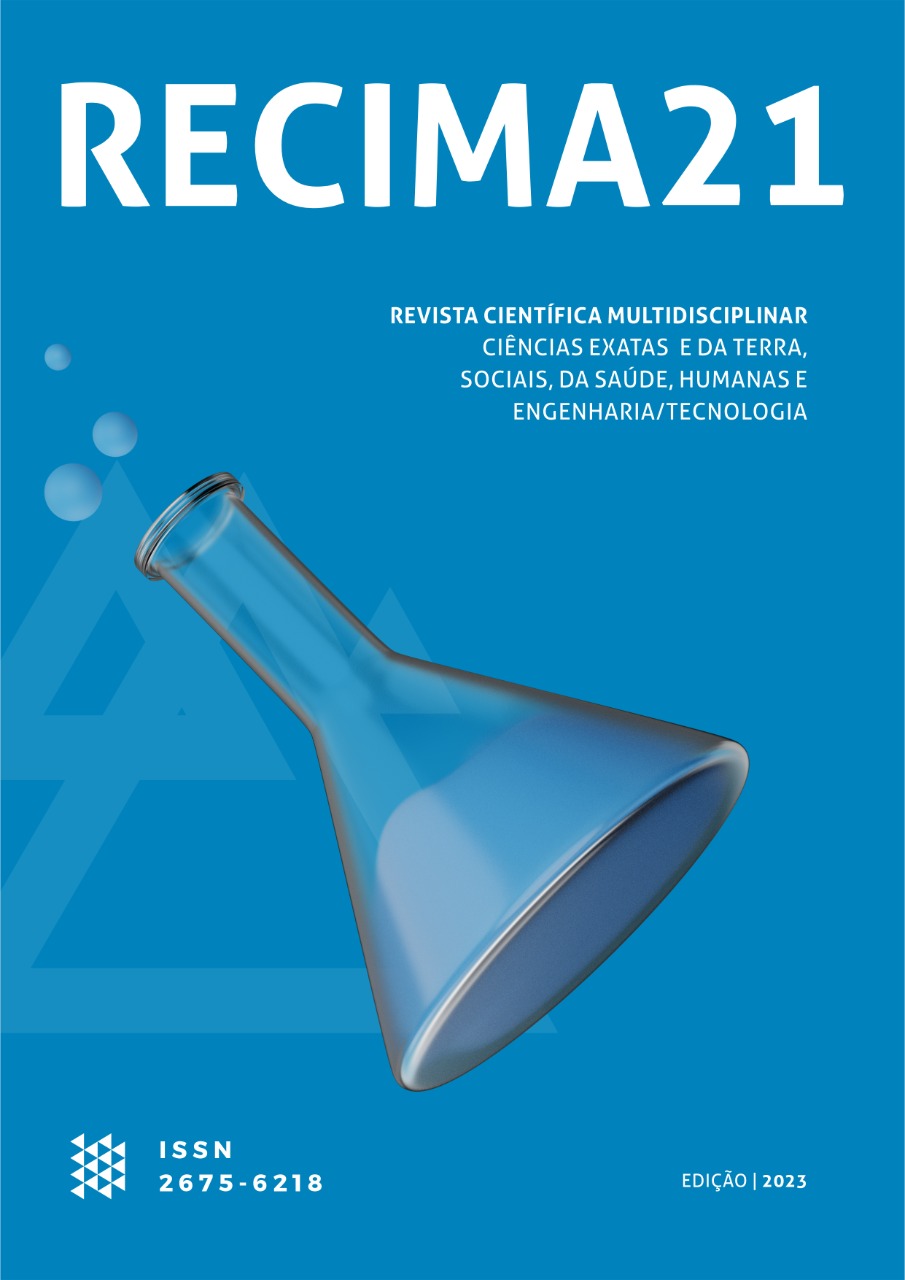ANÁLISE IN SILICO DO PROCESSO DE REGENERAÇÃO CELULAR ATRAVÉS DA INTERAÇÃO PIWI/PIRNA EM MUS MUSCULUS
DOI:
https://doi.org/10.47820/recima21.v4i11.4302Palavras-chave:
Biologia de sistemas, Interação PIWI/piRNA, Regeneração celularResumo
A regeneração celular e tecidual, muito abordada em diversas áreas da medicina e da biologia, ainda permanece com lacunas sobre seus processos e funcionamento. Na última década, elucidou-se o papel da epigenética na referida função, dando-se ênfase para RNAs não codificantes, e entre eles, os piRNAs (PIWI-interacting RNAs), antes conhecidos por sua atuação em células germinativas e no controle de elementos transponíveis. Estudos recentes demonstraram funções dos piRNA em células de tecidos somáticos, como o nervoso, e pesquisas com pequenos roedores, especialmente em Mus musculus, apontaram uma importante ligação entre a expressão dessa via e o correto funcionamento do processo de regeneração. Por ser um desafio relevante para a medicina regenerativa entender esses processos, através de estudos robustos aqui descritos e utilizando ferramentas de Bioinformática, construiu-se redes de interação proteína-proteína (PPIN) para identificar proteínas-alvo para tratamentos terapêuticos com base no funcionamento da via do gene PIWI/piRNA em Mus musculus. A partir da análise dessas redes, conseguimos identificar proteínas relevantes, assim como suas interações, para o processo regenerativo em mamíferos e, com esses resultados, futuramente, poder-se-á desenvolver testes in vivo com base nos dados obtidos in silico, economizando, assim, tempo e investimentos financeiros.
Downloads
Referências
CASOTTI, Matheus C.; MEIRA, Debora D. Construindo redes de interação proteína-
proteína por curadoria manual. Bioinfo, 2021.
COLTRI, Patricia Pereira. Caracterização de proteínas do spliceossomo e seu papel na
regulação do splicing e alterações celulares. 2021.
EUROPEAN BIOINFORMATICS INSTITUTE - QuickGO - Definition (GO:0035770
GONUTS page). Disponível em: https://www.ebi.ac.uk/QuickGO/term/GO:0035770. Acesso em 8
de setembro de 2023.
GRILLARI, Johannes; GRILLARI-VOGLAUER, Regina. Novel modulators of senescence,
aging, and longevity: Small non-coding RNAs enter the stage. Experimental gerontology, v. 45, n.
, p. 302-311, 2010.
KASHIMA, Makoto; AGATA, Kiyokazu; SHIBATA, Norito. What is the role of PIWI family
proteins in adult pluripotent stem cells? Insights from asexually reproducing animals, planarians.
Development, Growth & Differentiation, v. 62, n. 6, p. 407-422, 2020.
KIM, K. W. PIWI Proteins and piRNAs in the Nervous System. Mol. Cells, Seoul, v. 42, p.
-835, 2019.
LI, Danyan; TAYLOR, David H.; VAN WOLFSWINKEL, Josien C. PIWI-mediated control of
tissue-specific transposons is essential for somatic cell differentiation. Cell reports, v. 37, n. 1,
NAQVI, Afsar Raza et al. The fascinating world of RNA interference. International journal
of biological sciences, v. 5, n. 2, p. 97, 2009.
OW, M. C.; HALL, S. E. piRNAs and endo-siRNAs: Small molecules with large roles in the
nervous system. Neurochem Int., Syracuse, NY, v. 148, 2021.
OZATA, D. M et al. PIWI-interacting RNAs: small RNAs with big functions, Nature
Reviews, Genetics, Londres, v. 20, p. 89-106, 2019.
RAMAT, A.; SIMONELIG, M. Functions of PIWI Proteins in Gene Regulation: New Arrows
Added to the piRNA. Quiver, Trends Genet, Cambridge, v. 37(2), p. 188-200, 2021.
ROJAS-RÍOS, Patricia; SIMONELIG, Martine. piRNAs and PIWI proteins: regulators of
gene expression in development and stem cells. Development, v. 145, n. 17, p. dev161786, 2018.
ROSS, R. J.; WEINER, M. M.; LIN, H. Proteínas PIWI e RNAs que interagem com PIWI no
soma. Nature, Londres, v. 505, p. 353–359, 2014.
SATO, Kaoru; TAKAYAMA, Ken-ichi; INOUE, Satoshi. Role of piRNA biogenesis and its
neuronal function in the development of neurodegenerative diseases. Frontiers in Aging
Neuroscience, v. 15, p. 1157818, 2023.
TAVERNA, Simona; MASUCCI, Anna; CAMMARATA, Giuseppe. PIWI-RNAs Small
Noncoding RNAs with Smart Functions: Potential Theranostic Applications in Cancer. Cancers, v.
, n. 15, p. 3912, 2023.
TYCZEWSKA, Agata et al. The emerging roles of tRNAs and tRNA-derived fragments
during aging: Lessons from studies on model organisms. Ageing Research Reviews, p. 101863,
UNIPROT. UniProtKB: P07901 · HS90A_MOUSE. Disponível em:
https://www.uniprot.org/uniprotkb/P07901/entry. Acesso em: 8 de setembro de 2023.
UNIPROT. UniProtKB: Q9Z204 · HS90A_MOUSE. Disponível em:
https://www.uniprot.org/uniprotkb/Q9Z204/entry. Acesso em: 8 de setembro de 2023.
UNIPROT. UniProtKB: Q9R0Q7 · TEBP_MOUSE. Disponível em:
https://www.uniprot.org/uniprotkb/Q9R0Q7/entry. Acesso em: 8 de setembro de 2023.
UNIPROT. UniProtKB: Q14DK4 · GPAT2_MOUSE. Disponível em:
https://www.uniprot.org/uniprotkb/Q14DK4/entry. Acesso em: 8 de setembro de 2023.
WAKISAKA, K. T., IMAI, Y. The dawn of piRNA research in various neuronal disorders,
Frontiers In Bioscience, Landmark, Kyoto, v. 24, p. 1440-1451, 2019.
WEI, J.-W. et al. RNAs não codificantes como reguladores em epigenética (revisão).
Oncology Reports, Londres, v. 37(1), p. 3-9, 2017.
XU, C.; SUN, S. Expression of Piwi Genes during the Regeneration of Lineus sanguineus
(Nemertea, Pilidiophora, Heteronemertea). GENES, Basel, v. 11 (12), 2020.
Downloads
Publicado
Licença
Copyright (c) 2023 RECIMA21 - Revista Científica Multidisciplinar - ISSN 2675-6218

Este trabalho está licenciado sob uma licença Creative Commons Attribution 4.0 International License.
Os direitos autorais dos artigos/resenhas/TCCs publicados pertecem à revista RECIMA21, e seguem o padrão Creative Commons (CC BY 4.0), permitindo a cópia ou reprodução, desde que cite a fonte e respeite os direitos dos autores e contenham menção aos mesmos nos créditos. Toda e qualquer obra publicada na revista, seu conteúdo é de responsabilidade dos autores, cabendo a RECIMA21 apenas ser o veículo de divulgação, seguindo os padrões nacionais e internacionais de publicação.













